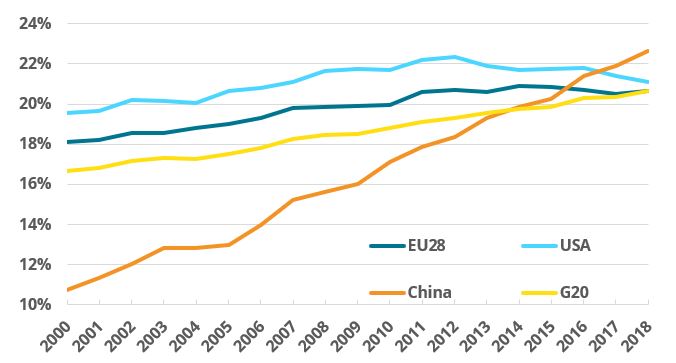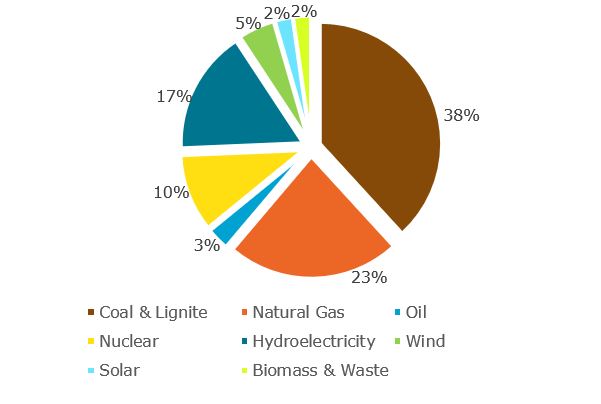An in-depth look at electrification trends worldwide
Get this executive brief in pdf format
Electrification is often presented as a key option to decarbonise the energy system. However, with coal accounting for a large part of power generation (38% in 2018), electricity is by no means emissions-free. In this context, to which extent can electrification contribute to the energy transition? And what remains to be done to further decarbonise power generation?
This brief has been prepared by Enerdata’s Research Department.
Electrification, a pillar of energy transition?
Electrification allows to improve both
- energy efficiency (1), since electric equipment is generally much more efficient than thermal one (e.g. heat pumps);
- and the carbon factor (2), since power generation could be significantly decarbonated. It therefore represents a key option to mitigate greenhouse gases (GHG) emissions.

Generally speaking, electricity fuels economic activity, social development, and helps to reduce local pollution. Electrification thus contributes to the United Nations’ seventh Sustainable Development Goal (SDG) for 2030, aiming to “ensure access to affordable, reliable, sustainable and modern energy for all”.
Final energy uses are converting to electricity … to a certain extent
Diverse dynamics for electrification
The share of electricity has been growing over the past decades due to fuel switch and the development of captive electricity uses. At global level, electricity demand is growing almost twice as fast as total energy demand with a 3% increase per year between 2000 and 2018 at world level. The share of electricity in the global final energy demand has steadily increased from 17% in 2000 to roughly 21% in 2018.
However, the observed trends are not the same for all countries and regions. In OECD countries, more specifically the United States (US) and the European Union (EU), the share of electricity in the final energy demand has increased by 1-2pp since 2000 with a stabilisation for the past five years due to progress in energy efficiency and advantageous climate conditions. In China, the dynamic is much stronger with a doubling of the share of electricity from 11% to more than 22% (higher than the rate observed in the US or the EU). This is mainly a result of fuel switch, the development of captive electricity equipment in buildings, tertiary sector expansion and a higher penetration of electric vehicles compared to other countries (due to public policies and investments aimed at reducing air pollution and developing Chinese industry and job creation in this new sector).
Figure 1: Share of electricity in final consumption by regions (2000-2018)

Source: Enerdata, Global and CO2 Energy data
Electrification must accelerate to reach global climate targets
At world level, the global electricity demand is expected to increase by 80 to 90% to reach both Nationally Determined Contributions (NDCs) objectives (EnerBlue scenario) and a +2°C scenario (EnerGreen) in 2050. The share of electricity in final consumption would reach 29% in EnerBlue, and 36% in EnerGreen (in relation with a strong decarbonisation of power generation), due to higher energy efficiency efforts.
For some countries, such as the US, the EU or Brazil, it would mean a strong acceleration of electrification whereas China, India or Japan would need to keep up with the existing dynamic trend.
Figure 2: Share of electricity in final consumption

Source: Enerdata, Global and CO2 Energy data, EnerFuture
Several drivers can contribute to an increasing share of electricity in the final demand:
- in buildings, the development of heat pumps in mature markets such as China, North America or Europe and the development of specific uses (appliances, information technologies and digitalization);
- in the industry, the development of robotisation, digitalisation, electric processes (e.g. the electric arc furnace) or heat pumps for low temperature;
- in transport, the development of electric vehicles and the electrification of public transportation (read our previous analysis on the development of electric vehicles by 2050: 50% of the global car fleet could be electric in 30 years).
Power generation needs to decarbonate more quickly
It is essential to decarbonate the power mix in order to harness the full potential of electrification regarding GHG objectives. Some progress has been made since 2012 with a decreasing carbon content of power generation, but it has proved to be far from sufficient. The overall power mix remains dominated by fossil fuels, especially coal.
Figure 3: Share of power generation by technology, world, 2018

Source: Enerdata, Global and CO2 Energy data
A strong acceleration in the decarbonisation of power generation is required to meet global climate objectives.
Figure 4: CO2 emissions of electricity production per kWh, world, 2000-2040

Source: Enerdata, Global Energy and CO2 data, EnerFuture
The main options to decarbonate the power mix are wind and solar, biomass, nuclear, fossil fuel switch, and Carbon Capture and Storage (CCS) in the long term.
Figure 5: Emission reduction options in power sector, world

Source: Enerdata, EnerFuture, AERO
Take-aways
- The share of electricity in the final energy consumption has been growing over the past decades, and, in a +1.5-2°C scenario, it could reach in 2040 up to 45% in some regions, and 35% globally. Some main drivers are:
- Heat pumps in buildings;
- Electric vehicles and modal shift in transportation;
- Specific electric heating processes in the industry.
- Power generation is still dominated by fossil fuels at a global level, but the carbon content of electricity could be reduced by around 75% in 2040 in a +1.5-2°C scenario.
- Electricity prices and electric equipment cost competitiveness will be a key driver.
- Electrification will play a key role in the global energy transition, but it will by no means be its only pillar. Actions such as decarbonizing other vectors (e.g. gas) or increasing energy efficiency will also be crucial.
 Energy and Climate Databases
Energy and Climate Databases Market Analysis
Market Analysis